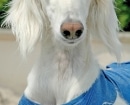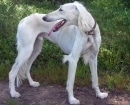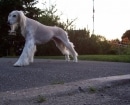Content |
|---|
History
The Saluki, commonly known as “Royal dog of egypt”, It is perhaps the oldest known breed of domesticated dog and the oldest of the Sighthounds, It is believed descended from wolves in the wilderness of Ara. The Bedouins hold them in high esteem and use them for hunting gazelles and as pets..
As in the case of some other breeds in United States, including the Basenji and the Portuguese Podengo, the current Saluki population is descended from a small number of the first dogs to be introduced to the country since the 19th century.
But, the original dogs imported to the United States.UU. they came through the Middle East, a wide geographical area, unlike most other castes who come from very small areas, so the Saluki have the largest genetic base among thoroughbreds.
Recently, the AKC (American Kennel Club) It has allowed the third generation of the Saluki's COO (country of origin) to be placed after the inspections of judges, so the genetic code base of the breed continues to increase further as more dogs are imported.
The Saluki is graphically described in the Egyptian tombs of 2100 to. C. and it is estimated that his body was often mummified like the bodies of the Pharaohs. Many of the early stone inscriptions represent the House of the young King Tutankhamon with his pair of Saluki real. Les has also be linked with other Pharaohs as King Antef.
Numerous remains of specimens have been found in the ancient tombs of the upper Nile region. The Saluki It has historically served as collector, a quick dog. Saluki dogs slept with their owners in tents to protect themselves from the heat of the day and the cold at night and since the desert tribes were nomads, the habitat of Saluki spanned the entire region from the Caspian Sea to the Sahara.
Rates varied, course, something in this widely scattered area, especially in the size and the color of his cloak. The Saluki was first brought to England in 1840 and known as the Persian Greyhound. There was never a true interest in raising it, until that Florence Amherst imported the first Saluki Arab in 1895 from Prince Abdulla's kennels in Transjordan.
In Persian Gulf countries, the Saluki is known as Tazi (the Gallop).
Physical characteristics
It is a square with a thin head, the skull is wider than the snout, almond-shaped and dark eyes, hanging ears, the neck is long and without belfos.
The chest is moderately wide deep, the body is a square but it gives an appearance of elongated with oblique and muscular backs, tail of low inclusion with a curve at the tip.
The hair changes according to the variety, in the Saluki long hair is smooth, silky and Wicks on extremities. In the variety of short hair Saluki, lacks Wicks, is the only difference.
The average lifespan of a Saluki is of, approximately, 14 years.
Character and skills
The Saluki he is a reserved dog with strangers, but is neither nervous nor aggressive. Worthy, intelligent and independent.
It has a great capacity for learning, instinct for protection, Guard instinct, herding instinct, hunting instinct, certain level of aggressiveness, a tendency to bark, but it adapts very well to living with other dogs and living with children.
It is a dog that requires activity, need space to feel free and plenty of exercise (If possible, more than 2 hours a day).
Curiosities
In his land of origin a dog Saluki cannot be sold. May only be offered as a gift to a close friend or highly respected guest, as a sign of admiration.
In Europe it is used exclusively as a companion and exhibition dog.. Y, copies of this canine breed tend to be high-cost.
Images “Saluki”
Videos “Saluki”
Characteristics "Saluki"
Coexistence is important that you have with your new friend. Before considering the acquisition of a dog of the breed "Saluki" you know certain factors. Not all breeds of dogs are apt to live in an apartment, you must take into account his character, their need for exercise, their interaction with other pets, their care and if you have small children, their level of tolerance towards them.
Adaptation ⓘ3.0 out of 5 stars (based on 1 review)
|
friendly dog ⓘ3.0 out of 5 stars (based on 1 review)
|
hair loss ⓘ2.0 out of 5 stars (based on 1 review)
|
|---|---|---|
Affection level ⓘ3.0 out of 5 stars (based on 1 review)
|
Need for exercise ⓘ4.0 out of 5 stars (based on 1 review)
|
Social need ⓘ3.0 out of 5 stars (based on 1 review)
|
Home ⓘ3.0 out of 5 stars (based on 1 review)
|
Toilet ⓘ5.0 out of 5 stars (based on 1 review)
|
Friendly with strangers ⓘ3.0 out of 5 stars (based on 1 review)
|
barking ⓘ2.0 out of 5 stars (based on 1 review)
|
Health ⓘ4.0 out of 5 stars (based on 1 review)
|
Territorial ⓘ2.0 out of 5 stars (based on 1 review)
|
Cat friendly ⓘ2.0 out of 5 stars (based on 1 review)
|
Intelligence ⓘ3.0 out of 5 stars (based on 1 review)
|
Versatility ⓘ3.0 out of 5 stars (based on 1 review)
|
Child friendly ⓘ4.0 out of 5 stars (based on 1 review)
|
Surveillance ⓘ2.0 out of 5 stars (based on 1 review)
|
joy ⓘ3.0 out of 5 stars (based on 1 review)
|
Breeders list "Saluki"
Type and recognitions:
- FCI CLASSIFICATION: 269
- Group 10: Sighthounds
- Section 1: Long-haired or fringed Sighthounds. Without working trial. .
Federations:
- FCI – Group 10: Section 1: Long-haired or fringed Sighthounds ⓘ
- AKC (Hound) ⓘ
- ANKC Group 4 (Hounds) ⓘ
- CKC Group 2 – Hounds ⓘ
- KC ⓘ
- NZKC (Hounds) ⓘ
- UKC Sighthounds & Pariahs ⓘ
FCI breed standard "Saluki"
Alternative names:
1. Gazelle hound, Arabian hound, Persian greyhound, Royal Dog of Egypt, Tazi (English).
2. Lévrier persan (French).
3. Persischer Windhund (German).
4. (em árabe: سلوقي) (Portuguese).
5. Galgo Persa, Perro real de Egipto, Tazi (español).













 Singing Saluki
Singing Saluki dog-saluki
dog-saluki The salukis in the morning “cuddle bite”
The salukis in the morning “cuddle bite” Saluki puppies and a bit first education
Saluki puppies and a bit first education
